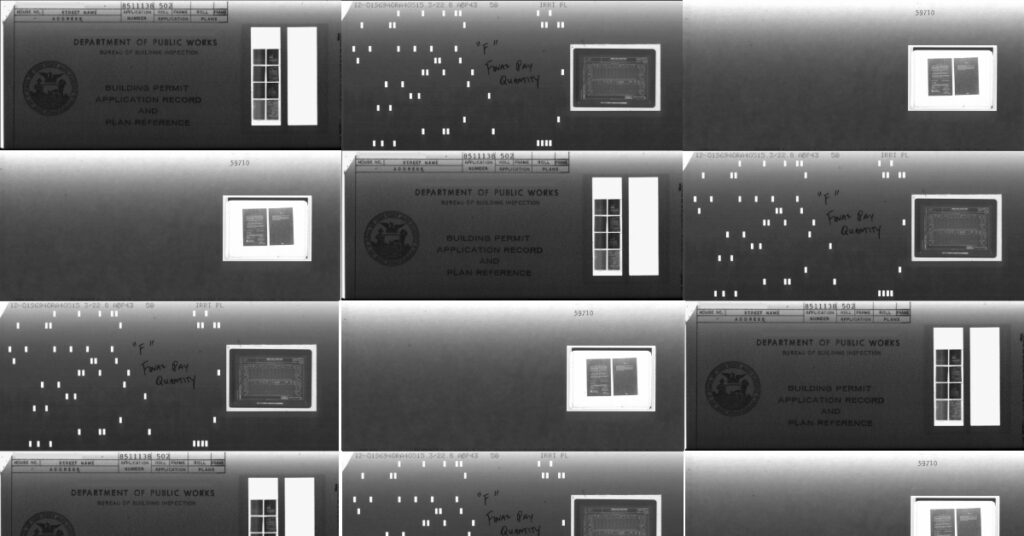Aperture cards stand out as the misfit of the microforms family. Aperture cards and microfiche are both part of the same “family” as microfilm, but the former is more common knowledge. Those records have probably been stored there for a long time.
Information on aperture cards, a type of microform, is provided in this article to help readers better understand the subtleties of this data storage medium, such as the advantages of aperture cards and the costs associated with aperture card scanning.
What Is An Aperture Card?
Different varieties of punched cards may be distinguished by the presence of a microfilm bearing an image in the center of a window. On top of that, machine-readable information is often included into the picture itself. In engineering and related industries, aperture cards are frequently used to draw out designs and blueprints. The card will often feature written information explaining the drawing, such as the drawing number, as well as punched holes. In addition, aperture cards, which played a significant role in the past, are being phased out in favor of digital means. Digitizing aperture cards is the process that allows for their use in an electronic environment.
What Are The Pros And Cons Of Using Aperture Cards?
Aperture cards were preferable to microfilm and microfiche in many ways.
- One, the picture on the card can be complemented by text that is either indexed or easily accessible. Document retrieval using this approach is much faster than the alternative, which involves progressively scanning across film to find the relevant image.
- Second, since each card just stores a single image, it’s considerably simpler to exchange or replicate certain information. There is the possibility that the card reader will additionally print data onto the card, such as the document’s serial number, category, and date of issuance. Handwritten notes are a great way to enhance indexed data. If you have an aperture card, you can read it without a film reader. Coloring your aperture cards in accordance with their respective categories is a great way to provide a visual layer of organizing.
- When it came to archiving and retrieving drawings and specifications, aperture cards were ideal because not only could they be viewed easily, but their indexing was also crystal clear and could be scanned fast. What’s more, they’re easily duplicated and relocated as individual visual components. Businesses in the manufacturing sector, government organizations, architectural and engineering firms, and many more all used aperture cards as a data storage medium.
When compared to microfilm and microfiche, the creation of aperture cards was more expensive. More space is needed to store aperture cards, and they are more easily lost or damaged than microfilm. Aperture cards have lost most of their value in today’s digital world. Computers are a far more effective means of storing both the graphical and textual representations of the specification. Despite this, aperture cards are still widely used by businesses and other organizations. Since the printed image may survive for generations and new copies can be generated fast from the punched cards, aperture cards seldom “wear out.” Aperture cards are expensive and inconvenient to store, therefore many companies are having them scanned into photographs or searchable pdfs.
How Do I Keep Track of My Aperture Cards?
The sizes of your aperture cards provide a quick and easy way to count them. To get an accurate card count, use the ruler to arrange the cards to within an inch of the edge. Roughly 100 playing cards can fit in such space. Now, roughly calculate your amount by adding all the linear inches or feet of aperture cards you have.
How much does it cost to digitize an aperture card?
Want to know how much it would set you back to digitize your aperture cards? The expense of aperture card scanning is highlighted. Once you have a ballpark figure, you may decide whether to digitize your files or continue using paper copies.
It’s common knowledge that microfilm and microfiche are the two most common types of microforms, with aperture cards standing out as the odd man out. And then there are the cards with the holes in them and the film strip on the right. This is a certain way to determine whether or not the other party is armed with aperture cards. Aperture cards are commonly used and well accepted as an alternative to microfilm and microfiche, despite their lesser notoriety. So that you may have a rough idea of what you could anticipate to pay, we’ll go through the numerous components that go into calculating the ultimate cost of aperture card conversion.
Aperture card digitizing price is determined by primary factors, including:
- Instances Of Playing Cards
- Indexing Resolution Requirements for Different Aperture Card Types
- Timing of Work by Subcontractors for a Construction Project
The Final Results of OCR Images and Data
Convert My Microfilm provides a number of solutions designed to improve workplace efficiency. Feel free to get in touch with us whenever your business is ready to explore aperture card conversion. If your business has any questions concerning aperture card conversion, please don’t hesitate to contact us.

